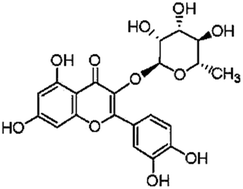Quercitrin offers protection against brain injury in mice by inhibiting oxidative stress and inflammation
Abstract
Quercitrin is one of the primary flavonoid compounds present in vegetables and fruits. The aim of the present study was to evaluate the effects of quercitrin against carbon tetrachloride (CCl4) induced brain injury and further to elucidate its probable mechanisms. ICR mice received CCl4 intraperitoneally with or without quercitrin co-administration for 4 weeks. Our data showed that quercitrin significantly suppressed the elevation of reactive oxygen species (ROS) production and malondialdehyde (MDA) content, reduced tissue plasminogen activator (t-PA) activity, enhanced the antioxidant enzyme activities and abrogated cytochrome P450 2E1 (CYP2E1) induction in mouse brains. Quercitrin also prevented CCl4 induced cerebral function disorders associated with its ability to inhibit the activities of monoamine oxidase (MAO), acetylcholine esterase (AChE) and the N-methyl-D-aspartate receptor 2B subunit (NR2B). In addition, western blot analysis showed that quercitrin suppressed the release of pro-inflammatory cytokines such as tumor necrosis factor alpha (TNF-α) and interleukin-6 (IL-6). Taken together, our findings suggested that quercitrin may be a potential candidate to be developed as a neuroprotective agent.


 Please wait while we load your content...
Please wait while we load your content...